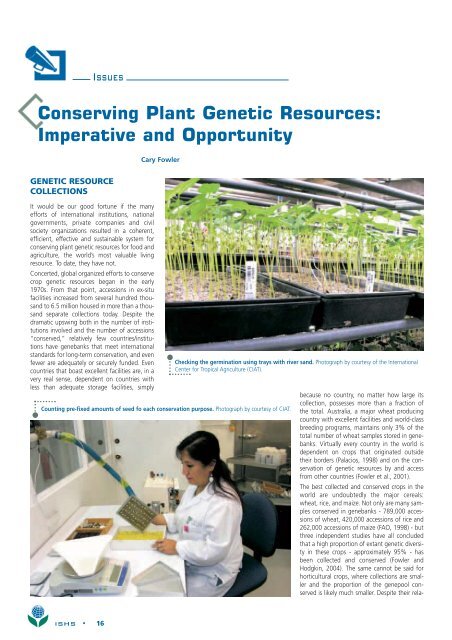Acta Horticulturae
Acta Horticulturae
Acta Horticulturae
You also want an ePaper? Increase the reach of your titles
YUMPU automatically turns print PDFs into web optimized ePapers that Google loves.
ISSUES<br />
Conserving Plant Genetic Resources:<br />
Imperative and Opportunity<br />
Cary Fowler<br />
GENETIC RESOURCE<br />
COLLECTIONS<br />
It would be our good fortune if the many<br />
efforts of international institutions, national<br />
governments, private companies and civil<br />
society organizations resulted in a coherent,<br />
efficient, effective and sustainable system for<br />
conserving plant genetic resources for food and<br />
agriculture, the world’s most valuable living<br />
resource. To date, they have not.<br />
Concerted, global organized efforts to conserve<br />
crop genetic resources began in the early<br />
1970s. From that point, accessions in ex-situ<br />
facilities increased from several hundred thousand<br />
to 6.5 million housed in more than a thousand<br />
separate collections today. Despite the<br />
dramatic upswing both in the number of institutions<br />
involved and the number of accessions<br />
“conserved,” relatively few countries/institutions<br />
have genebanks that meet international<br />
standards for long-term conservation, and even<br />
fewer are adequately or securely funded. Even<br />
countries that boast excellent facilities are, in a<br />
very real sense, dependent on countries with<br />
less than adequate storage facilities, simply<br />
Counting pre-fixed amounts of seed fo each conservation purpose. Photograph by courtesy of CIAT.<br />
Checking the germination using trays with river sand. Photograph by courtesy of the International<br />
Center for Tropical Agriculture (CIAT).<br />
because no country, no matter how large its<br />
collection, possesses more than a fraction of<br />
the total. Australia, a major wheat producing<br />
country with excellent facilities and world-class<br />
breeding programs, maintains only 3% of the<br />
total number of wheat samples stored in genebanks.<br />
Virtually every country in the world is<br />
dependent on crops that originated outside<br />
their borders (Palacios, 1998) and on the conservation<br />
of genetic resources by and access<br />
from other countries (Fowler et al., 2001).<br />
The best collected and conserved crops in the<br />
world are undoubtedly the major cereals:<br />
wheat, rice, and maize. Not only are many samples<br />
conserved in genebanks - 789,000 accessions<br />
of wheat, 420,000 accessions of rice and<br />
262,000 accessions of maize (FAO, 1998) - but<br />
three independent studies have all concluded<br />
that a high proportion of extant genetic diversity<br />
in these crops - approximately 95% - has<br />
been collected and conserved (Fowler and<br />
Hodgkin, 2004). The same cannot be said for<br />
horticultural crops, where collections are smaller<br />
and the proportion of the genepool conserved<br />
is likely much smaller. Despite their rela-<br />
ISHS • 16
















